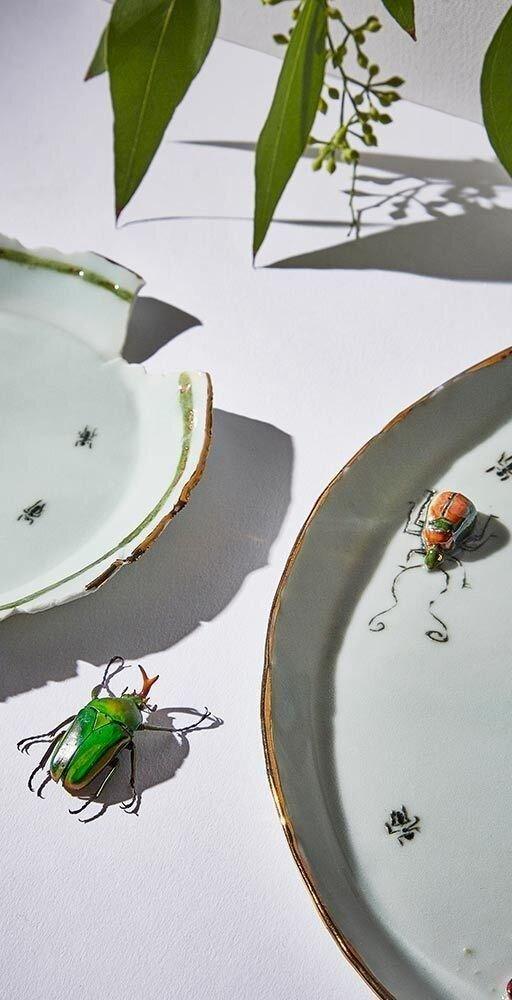Marc Armitano Domingo’s Enlightened Heirlooms Draw On Classical Music
I love seeing young talent creating classic items inspired by nature. I still use my grandmother's china for holidays and my collected china sets for even simple dinner occasions. Marc Armitano Domingo is a ceramicist and musician who handcrafts each piece of dishware for his one-year-old online shop Botticelli Ceramics. A native of Palo Alto, California, and only 22 years old, Armitano Domingo wields an impressive command of 17th- and 18th-century history and culture. Speaking with him about his artistic influences feels akin to time-traveling to a former hedonistic world unapologetic in its elitism and decadence. Equal parts beautiful, dark, and humorous, his porcelain creations channel the luxurious fascinations of the Renaissance nobility, from wunderkammer to vanitas paintings. The ceramics, distinguished by little sculpted insects and etchings of various characters performing uncanny acts, meld playfulness with elegance.
Botticelli may still be in its infant stage but already has a rapidly growing following that recognizes Armitano Domingo’s eye for distinct details. Gentle slopes and indentations run across the surface and edges of the different objects, making apparent their creator’s delicate touch. The ceramicist also marks some plates with intentional chips and cracks as an allusion to the concept of fleeting beauty. Each object is shaped, decorated, and fired in a studio uptown. Armitano Domingo notes that he bears little patience for exploring technical nuances in porcelain making. Instead, his skills seem entirely instinctive. One of his earliest memories with ceramics is a vase that he created in fifth grade, which he molded in the shape of a mermaid. When faced, at that time, with a choice between Boy Scouts and clay class, he opted for the latter. Years elapsed between then and last summer, when he reignited his interest in the craft and started his business.

Much like the forms of his dishware, Armitano Domingo’s decision to mature his ceramics practice as a young adult came about organically. He credits Mary Galvin, the mother of a close friend and a veteran of Fishs Eddy - who has styled dinnerware for Maialino, M. Wells, Blue Hill at Stone Barns, Joseph Leonard, and many others as one of the reasons he took up porcelain-making. As a college student, Armitano Domingo began frequenting Galvin’s home a couple of years ago homesick for California. Dinners there became a regular occurrence and he quickly became inspired by her charming tablescapes. Of his practice, she comments, “Marc is a bully when it comes to aesthetics, and I think that’s why his dishes look so good. He really feels what he is doing. This is what he loves.” Galvin is clearly not the only one to acknowledge this, as Botticelli’s first retail foray outside of its e-shop debuted as a special trunk show collection for Moda Operandi this November.
The ceramicist’s innate understanding of aesthetics stems from a lifelong love of music. He became fascinated with classical compositions as a young child, and has been studying the viola da gamba, an instrument that was almost exclusively played by the nobility and particularly fashionable among the French, for 10 years. A former student at Baltimore’s Peabody Conservatory, Armitano Domingo gushes with boyish enthusiasm as he presents to me his instrument of choice, animatedly pointing out all its Old World details. His love for ceramics and music are parallel, rather than separate, pursuits. “A lot of my inspiration comes from music and instrument making,” he says. His favorite orchestras are those performed by musicians who studied historical performance and play on original instruments, so it comes as no surprise that Botticelli is ultimately an homage to the Renaissance-era artisans who shaped instruments for noble patrons.
Armitano Domingo’s musical influence extends beyond an appreciation for masterful and ornate craftsmanship. Many of his engraved motifs are directly drawn from the whimsical images that adorn musical scores, as well as tales of saints and deities who are believed to be singers and musicians of supernatural prowess. Moreover, the designs as well as the engraving technique come from instrument ornamentation. Otto van Veen’s early 17th-century work Amorum Emblemata, a collection of engravings accompanied by love poems by lyricists and philosophers, also provides fodder for the new. “In a lot of music, there is not very much ornamentation written in, so you have to make your own on the notes. It’s like ornamenting a simple plate,” explains the ceramicist. His carefree manner leads me to believe that, contrary to the austerity with which many of us view the Renaissance period’s strict symbolism, Armitano Domingo is merely having a great deal of fun.
Written By Ashley Yeates & Michelle Saar

